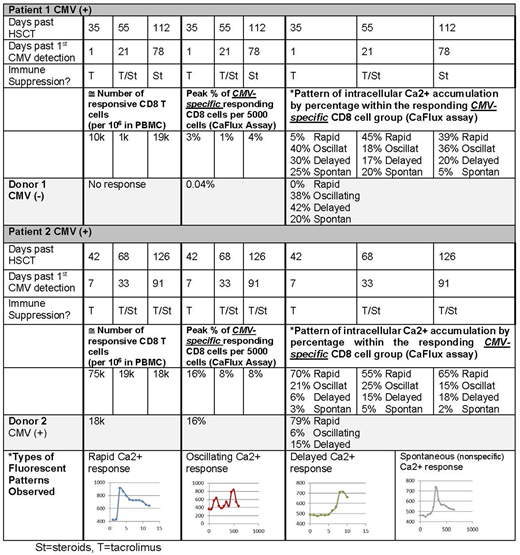Abstract
CMV reactivation post HSCT has been associated with an expansion of the CD3/8 T cell (CD8) compartment. We reported that in patients undergoing T replete 2 step HI HSCT, CMV reactivation resulted in inferior rates of non-relapse mortality and overall survival compared to non-reactivators despite increased CD8 numbers. (Gooptu, M. et al., Blood, 2014, 124:1170). We assessed whether defects in the quality of CD8 responses potentially mitigated the robust quantitative response in post HI HSCT patients reactivating CMV.
Blood from HI HSCT recipients with CMV reactivation was analyzed using the CaFlux assay. This assay was developed at our institution and measures changes of intracellular Ca2+ in real time by fluorescent microscopy in CD8 cells responding to cognate peptides. The T cells form a continuous monolayer, enabling the cells to present peptides to each other. The approach allows the evaluation of the kinetics of intracellular Ca2+ signaling on the level of individual cells. A complete description is found in Anikeeva et al., Nature Communications, 2016, 7:13264.
The assay was used to measure the percentage of responding CMV-specific CD8 cells and the pattern of intracellular Ca2+ accumulation in 4 recipients reactivating CMV post HI HSCT. Observed patterns of response were rapid (normal), oscillating (inefficient), delayed, and spontaneous (non-specific and erratic). Analyzed patients had 1 to 3 HLA alleles capable of presenting 2 to 6 CMV peptide epitopes used for the assay. CMV serostatus of recipient/donor pair 1 was +/-. The other 3 pairs were CMV +/+. There was 100% donor T cell chimerism at the time of sampling in all patients.
Responses were best characterized in patients 1 and 2 (shown in the table) due to the availability of sampling at earlier and multiple times and analyses of donor samples serving as comparison. Patient 1, with the CMV- donor, was on tacrolimus and/or steroids throughout sampling. CMV reactivation was evident from d+35 to d+47. There was a low frequency of CMV-specific CD8 cells which worsened with steroid therapy, although the quality of Ca2+ responses improved over time despite continued immune suppression. Patient 2 with a CMV+ donor was on tacrolimus and/or steroids throughout sampling. CMV reactivation was evident from d+35 to d+56. Initial testing showed a strong response in frequency and a very rapid Ca2+ response that was similar to the patient's CMV+ donor. The addition of steroids disproportionately affected frequency as opposed to the qualitative pattern of Ca2+ responses of CMV-specific CD8 cells in this patient.
Patients 3 and 4 had one-time samples drawn well after the resolution of CMV. Neither patient had been treated with steroids post HSCT, and immune suppression had been tapered off 1-2 months prior to sampling. Peripheral blood CD8 counts were 931 and 862 cells/ul respectively. After stimulation with antigenic peptides, only 0.7% of responding CD8 cells were CMV specific in patient 3. Patterns of intracellular Ca2+ accumulation in responding CMV-specific CD8 cells were 26% rapid, 42% oscillating, 22% delayed, and 10% spontaneous. A higher frequency of response was observed in patient 4 as compared to patient 3, with 5% of responding CD8 cells CMV specific, but patterns of Ca2+ accumulation, <2% rapid, 38% oscillating, 52% delayed, and 8% non-specific were poorer.
This analysis showed that in some patients, despite robust CD8 counts in the blood and the absence of immune suppression, the quality of CMV-specific CD8 responses is poor for an extended time after HI HSCT. Whether this finding predicts for a poorly reconstituting immune system in general requires further investigation but may explain inferior outcomes in patients with CMV reactivation. In other patients, Ca2+ responses to CMV are of better quality, or in the case of a CMV- donor, improve rapidly. Steroid administration negatively impacted the frequency of CMV-specific CD8 cells more so than their response pattern. The analysis provides insights into the robustness or lack thereof of the post HI HSCT immune system beyond quantification of T cell numbers.
No relevant conflicts of interest to declare.
Author notes
Asterisk with author names denotes non-ASH members.


